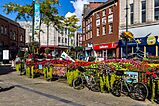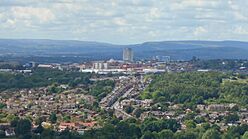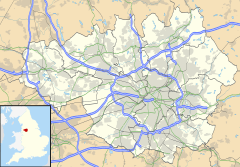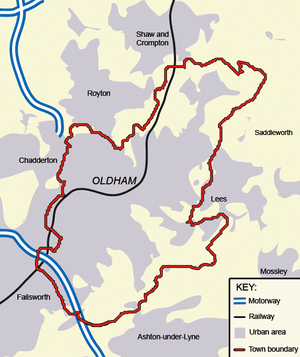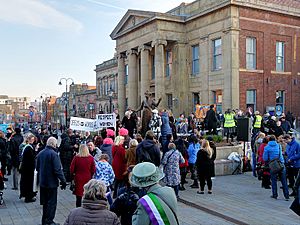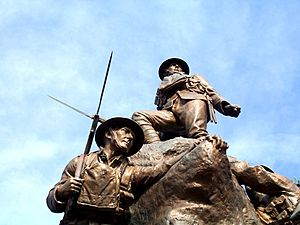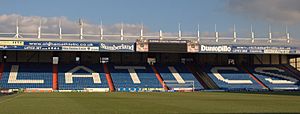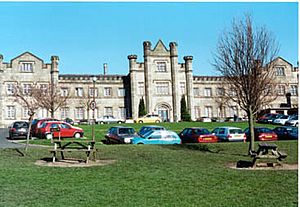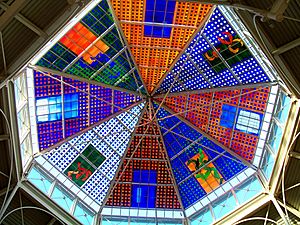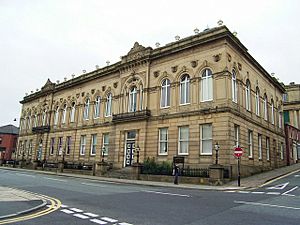Oldham facts for kids
Quick facts for kids Oldham |
|
|---|---|
|
|
|
| Area | 6.9 sq mi (18 km2) |
| Population | 96,420 (2011 Census) |
| • Density | 5,785/sq mi (2,234/km2) |
| OS grid reference | SD922053 |
| • London | 164 mi (264 km) SSE |
| Metropolitan borough | |
| Metropolitan county | |
| Region | |
| Country | England |
| Sovereign state | United Kingdom |
| Post town | Oldham |
| Postcode district | OL1-OL4, OL8, OL9 |
| Dialling code | 0161 |
| Police | Greater Manchester |
| Fire | Greater Manchester |
| Ambulance | North West |
| EU Parliament | North West England |
| UK Parliament |
|
Oldham is a town located in Greater Manchester, England. It sits on high ground among the Pennines hills, between the Irk and Medlock rivers. It is about 7 miles (11 km) northeast of Manchester. In 2019, the wider area of the Metropolitan Borough of Oldham had a population of 237,110 people.
Oldham was historically part of Lancashire. It became very important in the 1800s as a global hub for making textiles. It was a "boomtown" during the Industrial Revolution, meaning it grew very quickly. Oldham was one of the first industrial towns, soon becoming a major center for cotton and textile industries in England.
At its busiest, Oldham was the world's top producer of cotton spinning. It made more cotton than France and Germany combined! However, Oldham's textile industry started to decline in the mid-1900s. The last cotton mill in the town closed in 1998.
The end of the textile industry greatly affected Oldham's local economy. Today, the town center is being redeveloped to become a hub for further education and performing arts. You can still see many old cotton mills and other buildings from its industrial past, which give the town its unique look.
Contents
- History of Oldham
- How Oldham is Governed
- Geography and Landscape
- People of Oldham
- Oldham's Economy
- Important Landmarks
- Getting Around Oldham
- Sports in Oldham
- Media in Oldham
- Education in Oldham
- Public Services
- Culture and Arts
- International Connections
- Britain in Bloom Success
- Famous People from Oldham
- See also
History of Oldham
What's in a Name? The Meaning of "Oldham"
The name Oldham likely means "old village" or "old place." It comes from the Old English word Eald (meaning old) and the Old Norse word holmi or holmr (meaning a piece of land sticking out, like a promontory). This might describe the town's location on a hilltop. Some also think it could mean "holm of a farmer named Alda." The name is thought to date back to 865 AD, during the time of the Danelaw.
Oldham's Early Days
The very first signs of people living in the Oldham area are Neolithic flint arrowheads. These tools suggest people lived here 7,000 to 10,000 years ago. Later, there's proof of Roman and Celtic activity, like an old Roman road and Bronze Age items.
Oldham was a small collection of settlements on the moorland until the Industrial Revolution. It was connected by dirt tracks between Manchester and York. In the 13th century, Oldham was a manor owned by a family called Oldham.
The Industrial Revolution and Cotton Boom
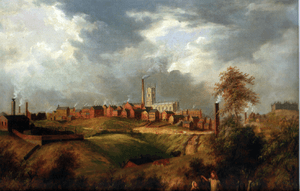
A big part of Oldham's history is linked to making textiles during the Industrial Revolution. People say that Oldham was put "firmly and squarely on the map of the world" by this revolution. Before factories, the area was used for grazing sheep. This provided wool for a local weaving trade done at home.
By 1756, Oldham was a center for making hats. The rough felt used gave people from Oldham the nickname "Owdham Roughyed." In the late 1700s, Oldham changed from a town where people made woollen clothes by hand at home to a huge industrial city with textile factories.
Oldham's first cotton mill, Lees Hall, was built around 1778. This started a fast process of growth and change. Within a year, 11 more mills were built. By 1818, there were 19 mills. The town's population grew from just over 12,000 in 1801 to 137,000 in 1901. This fast growth meant Oldham became a "factory town" very quickly.
In the second half of the 1800s, Oldham became the world's main center for cotton spinning. By 1851, over 30% of Oldham's people worked in textiles. Oldham had more spindles (parts of spinning machines) than any country except the United States in 1871. By 1909, it was spinning more cotton than France and Germany combined! At its peak, there were over 360 mills, working day and night.
Oldham was badly affected by the Lancashire Cotton Famine from 1861 to 1865. This happened when cotton supplies from the United States were cut off. The town relied completely on textiles, so many people lost their jobs. To help, a committee bought land to employ cotton workers to build Alexandra Park, which opened in 1865. As cheaper foreign yarns came in during the 1900s, Oldham's economy struggled. The last cotton was spun in Oldham in 1998.
Engineering the Future: Machines for Mills
Oldham's growing textile industry also led to a strong engineering sector. Making spinning and weaving machines became important in the late 1800s. The Platt Brothers, originally from nearby Dobcross, moved to Oldham. They were leaders in cotton-spinning machinery, creating new products that helped mass-produce cotton yarn.
Platt Brothers became the world's largest textile machine makers. They employed over 15,000 people in the 1890s. The company was a big investor in the local area. John and James Platt helped Oldham become a Borough. John Platt was even Mayor of Oldham three times and later became a Member of Parliament (MP) for Oldham.
Another important engineer was Philip Sydney Stott. He designed over a hundred mills in several countries. His factories helped Oldham's spindle count increase by 40% between 1887 and 1914.
Digging for Black Gold: Coal Mining in Oldham
Oldham also had a large coal mining industry. This supported the local cotton mills and the town's people. There's evidence of small-scale coal mining as early as the 1500s. The Oldham Coalfield stretched from Royton to Bardsley.
In the mid-1800s, Oldham's coal was mainly from many small mines. By 1851, over 2,000 men worked in collieries (coal mines) in Oldham. However, the amount of coal was overestimated, and production started to decline even before the cotton industry. Today, only old mine shafts remain.
Social Changes and Community Life
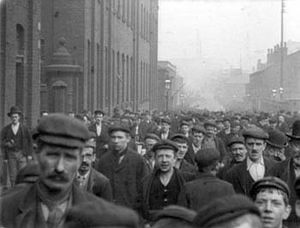
Oldham's social history includes protests and movements by working-class people. People in Oldham became very active in politics in the early 1800s. The town often saw protests over food prices and jobs, especially when new cotton-spinning machines were introduced.
On August 16, 1819, a large group from Oldham, estimated at over 10,000 people, went to St Peter's Fields in Manchester. They were there to hear speakers talk about political reform. This event became known as the Peterloo Massacre, where people were injured and some died. John Lees, a cotton worker and former soldier from Oldham, was one of the victims.
Annie Kenney, who worked in Oldham's cotton mills, was a famous member of the Suffragette movement. She helped start more active protests for women's right to vote. The Oldham Women's Suffrage Society was set up in 1910.
In May 2001, Oldham gained national attention due to conflicts and tensions between local communities. These events led to major riots in the town. After the riots, government and independent groups worked on improving community relations and starting regeneration projects in Oldham.
How Oldham is Governed
Oldham's Civic Journey
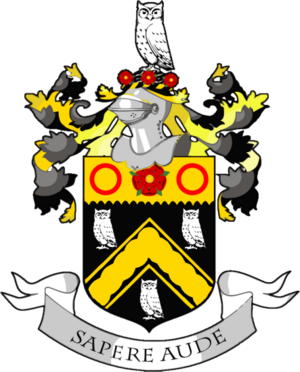
Oldham has been part of Lancashire since the early 1100s. In 1212, it was recorded as part of the Kaskenmoor estate. In 1826, groups were set up to improve Oldham. The town became a parliamentary borough in 1832. In 1849, Oldham officially became a municipal borough, which gave it special status.
The Local Government Act 1888 created elected county councils. If a municipal borough had over 50,000 people, it became a county borough. Oldham had 111,343 people in 1881, so it became a county borough on April 1, 1889. This meant it had the powers of both a borough and a county council.
Since 1961, Oldham has been twinned with Kranj in Slovenia. In 1974, Oldham's county borough status ended. Since then, it has been part of the Metropolitan Borough of Oldham within Greater Manchester.
Oldham's Voice in Parliament
Oldham is divided into two parliamentary constituencies: Oldham East and Saddleworth and Oldham West and Royton. These areas are represented by Labour Members of Parliament (MPs) Debbie Abrahams and Jim McMahon.
Winston Churchill started his political career in Oldham. He was elected as the MP for Oldham in the 1900 general election for the Conservative Party. He held this position until 1906. After he became Prime Minister of the United Kingdom in 1940, Churchill was made an Honorary Freeman of the Borough of Oldham in 1941.
| Oldham West and Royton | Oldham East and Saddleworth |
|---|---|
 |
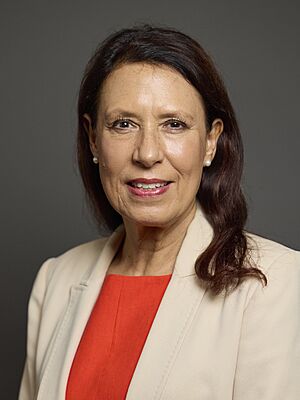 |
| Jim McMahon | Debbie Abrahams |
| Labour | Labour |
Geography and Landscape
| Weather chart for Oldham | |||||||||||||||||||||||||||||||||||||||||||||||
|---|---|---|---|---|---|---|---|---|---|---|---|---|---|---|---|---|---|---|---|---|---|---|---|---|---|---|---|---|---|---|---|---|---|---|---|---|---|---|---|---|---|---|---|---|---|---|---|
| J | F | M | A | M | J | J | A | S | O | N | D | ||||||||||||||||||||||||||||||||||||
|
70
6
1
|
50
7
1
|
60
9
3
|
50
12
4
|
60
15
7
|
70
18
10
|
70
20
12
|
80
20
12
|
70
17
10
|
80
14
8
|
80
9
4
|
80
7
2
|
||||||||||||||||||||||||||||||||||||
| temperatures in °C precipitation totals in mm |
|||||||||||||||||||||||||||||||||||||||||||||||
|
Imperial conversion
|
|||||||||||||||||||||||||||||||||||||||||||||||
Oldham is about 700 feet (213 meters) above sea level. It is 6.9 miles (11.1 km) northeast of Manchester city centre. The town is on high ground between the Irk and Medlock rivers. To the east are Saddleworth and the South Pennines. On other sides, Oldham is surrounded by towns like Ashton-under-Lyne, Chadderton, and Royton. There isn't much green space between them.
Oldham has a temperate maritime climate, like most of the British Isles. This means it has relatively cool summers and mild winters. It rains regularly, but usually not heavily.
Oldham's landscape is known for its rugged, elevated Pennine terrain. The River Beal flows north and forms the border between Oldham and Royton. The land rises to 1,225 feet (373 m) at Woodward Hill, near Saddleworth. The rest of the area is hilly, getting lower towards Manchester. Oldham Edge, an 800-foot (244 m) high ridge, runs through the town center.
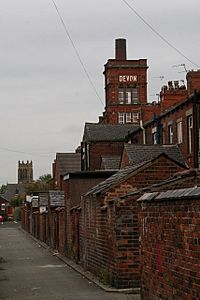
Oldham's buildings are mostly 19th-century red-brick terraced houses. These were built to support the town's former cotton mills. The town's shape is a bit unusual compared to other English towns. This is because of its hilly land. There are houses and streets clustered around the central business district in the town center.
In the 1800s, Oldham had a strong economy. However, local business owners didn't spend much on public buildings. Because of this, Oldham's architecture has been called "mediocre." The town doesn't have any buildings with a Grade I listing, which means they are of exceptional interest.
Oldham has a mix of busy urban areas, suburbs, and some rural spots. Most of the land is used for urban development. The M60 motorway passes through the southwest of Oldham. A heavy rail line also enters Oldham from the southwest, going through the town center and then north.

Neighborhoods and Areas of Oldham
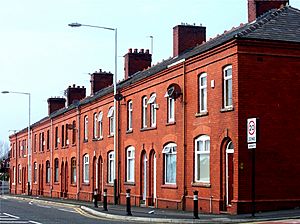
Many of Oldham's current neighborhoods were once small villages or common lands before the Industrial Revolution. Some, like Moorside, are newer residential areas. Others, like Hollinwood, are industrial areas and electoral wards. In the past, Oldham was surrounded by large areas of moorland, which you can still see in names like Moorside and Greenacres Moor.
Most of Oldham's homes are "low value" Victorian era red-brick terraced houses. These were built mostly between 1870 and 1920 to house the town's cotton mill workers. Newer housing can be found in the semi-rural east of the town.
One of Oldham's oldest named places is Hathershaw, mentioned in a document from 1280. Waterhead, an upland area in eastern Oldham, started with a water cornmill. Derker was recorded as a place to live in 1604. It is now being redeveloped. Coldhurst, along Oldham's northern border, was once a chapel area with a lot of industry, including coal mining and hat making.
People of Oldham
| UK Census 2011 | Oldham | Oldham (Met. District) | England |
| Total population | 96,555 | 217,273 | 53,012,456 |
| Foreign born | 15% | 8.2% | 17.57% |
| White British | 55.4% | 77.5% | 85.4% |
| Asian | 37.6% | 18.1% | 7.8% |
| Black | 2% | 1.2% | 3.5% |
| Christian | 58% | 73% | 59.4% |
| Muslim | 25% | 11% | 5% |
| Hindu | 1.1% | 0.1% | 1.5% |
| No religion | 8.3% | 8.9% | 24.7% |
| Over 65 years old | 12% | 14% | 16.33% |
| Unemployed | 5.5% | 3.7% | (7.6–8.4%) |
In 2001, Oldham had a population of 103,544, making it the 55th most populated settlement in England. The local population is mainly "working class" people.
Oldham has a high number of people from South Asian backgrounds, especially those with roots in Pakistan and Bangladesh. Because Oldham was an industrial center, it attracted workers from many places throughout its history. This included people from other parts of England, Scotland, Ireland, and Poland.
In the 1950s and 1960s, people from the Commonwealth of Nations were encouraged to move to Oldham to help with worker shortages. Many came from the Caribbean and the Indian subcontinent. Today, Oldham has large communities with heritage from Pakistan, India, Bangladesh, and parts of the Caribbean.
Oldham's population grew rapidly in the 1800s. It went from under 2,000 people in 1714 to 137,000 in 1901. In 1851, with 52,820 people, Oldham was the 12th most populated town in England. After peaking in 1911, the population generally declined in the 1900s.
| Year | 1801 | 1811 | 1821 | 1831 | 1841 | 1851 | 1861 | 1871 | 1881 | 1891 |
|---|---|---|---|---|---|---|---|---|---|---|
| Population | 12,024 | 16,690 | 21,662 | 32,381 | 42,595 | 52,820 | 72,333 | 82,629 | 111,349 | 131,463 |
| Year | 1901 | 1911 | 1921 | 1931 | 1939 | 1951 | 1961 | 1971 | 1981 | 1991 |
| Population | 137,246 | 147,483 | 144,983 | 140,314 | 120,511 | 121,266 | 115,346 | 105,922 | 107,830 | 103,931 |
| Year | 2001 | 2011 | Sources: A Vision of Britain through Time | |||||||
| Population | 103,544 | 98,555 | ||||||||
In 2011, 77.5% of the Oldham metropolitan borough population was White British, 18.1% Asian, and 1.2% Black. In the town of Oldham itself, 55.4% of the population was White British, 37.6% Asian, and 2% Black.
Oldham's Economy
For many years, Oldham's economy relied heavily on manufacturing, especially textiles and machine making. After the decline of these industries in the mid-1900s, new sectors like home shopping, publishing, healthcare, and food processing have grown. However, many of these new jobs are lower-skilled and lower-paying.
Oldham's town center has the most shops, cultural places, and jobs in the Metropolitan Borough of Oldham. It has been greatly redeveloped. Its two shopping centers, Town Square and the Spindles, are now among the largest covered shopping areas in Greater Manchester. The Spindles shopping center is named after textile spindles. It has over 40 shops, banks, and food places. It also features some of Europe's largest stained glass artworks by local artist Brian Clarke. These celebrate the life and music of Sir William Walton, a famous composer from Oldham.
Oldham has been a place of innovation in food and medicine. The tubular bandage was invented and developed in Oldham in 1961. This important medical advance came from a partnership between a local company, Seton, and a cotton manufacturer. Some people claim that Oldham was where the first chip shop started, around 1858–60, at what is now Tommyfield Market. In 1900, Oldham had the most chip shops in the country, with one for every 400 people. Rag Pudding is a savory dish said to be unique to Oldham. Yates Wine Lodge was also founded in Oldham in 1884.
Park Cake Bakeries, located in Hathershaw, is a large food processing center. It employs over 1,600 people and sends more than 90% of its cakes to Marks & Spencer. Ferranti Technologies, an engineering company, is based in Waterhead.
Important Landmarks
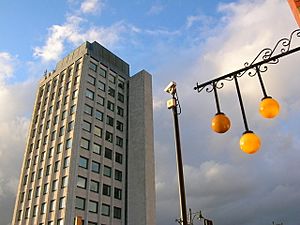
The Old Town Hall: A Historic Building
Oldham's Old Town Hall is a Grade II listed building. This means it's an important historic structure. It was built in 1841, before Oldham officially became a borough. It has a grand Ionic portico, which is a fancy entrance with columns, similar to an ancient Greek temple.
Winston Churchill gave his first acceptance speech from the steps of the town hall when he was elected as an MP in 1900. A Blue Plaque on the building marks this event. The town hall was the political center of Oldham for many years, with courtrooms inside. It was empty for a long time from the mid-1980s.
In 2009, the Victorian Society called Oldham Town Hall the most endangered Victorian building in England and Wales. However, plans to turn it into a leisure complex with a cinema and restaurants were approved in 2012. This project, costing £36.72 million, was finished in 2016. The Old Town Hall is now a modern multiplex Odeon cinema in the heart of Oldham's shopping area.
Oldham War Memorial: Remembering Heroes
The Oldham War Memorial was built to remember the men from Oldham who died in the First World War. It has a granite base with a bronze sculpture on top. The sculpture shows five soldiers moving through trenches towards battle. The main figure is climbing out of the trenches, calling his comrades forward.
The memorial was designed by Albert Toft and unveiled on April 28, 1923, by General Sir Ian Hamilton. Over 10,000 people attended the ceremony. The monument was meant to represent the spirit of the war years (1914–1918).
The Civic Centre: Oldham's Government Hub
The Civic Centre tower is where the Metropolitan Borough of Oldham's local government operates. The Mayor of Oldham has an office here. This 15-story white-brick building has most of the local government offices and was finished in 1977.
Standing at the highest point in town, the tower is over 200 feet (61 m) tall. It was designed by Cecil Howitt & Partners. You can see the Civic Centre from far away, including Salford and Wythenshawe. It offers amazing views across Manchester and the Cheshire Plain.
Churches in Oldham
The Oldham Parish Church of St. Mary with St. Peter was built in its current form in 1830. It was designed in the Gothic Revival Style by Richard Lane. It is a Grade II* listed building, meaning it's very important. A church has been on this site since 1280.
During the Industrial Revolution, Oldham's population grew very fast. This meant the church needed to be rebuilt to be much larger. The new church cost £30,000, much more than planned. The church is still actively used for worship today.
Oldham also has Roman Catholic churches, such as Our Lady of Mount Carmel and St Patrick Church. It was built in 1870 and is a Grade II listed building.
Getting Around Oldham
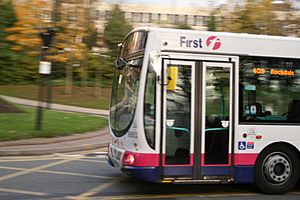
Oldham's hilly geography made it hard to build big transport links. Oldham has never been on a main railway line, and canals could only reach it from a distance.
Oldham used to have six railway stations, but this was reduced to three. These three stations closed in 2009. Trains from Manchester Victoria station to Oldham had to climb steeply. The Werneth Incline, with a slope of 1 in 27, was the steepest regular passenger line in the country.
The old Oldham Loop Line was changed into part of the Metrolink light rail network, now called the Oldham and Rochdale Line. Trams started running between Victoria and a temporary Oldham Mumps tram stop in 2012. More central stops opened in 2014.
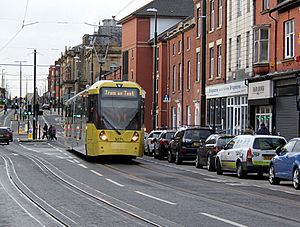
Oldham had electric tramways to Manchester in the early 1900s, but they stopped running in 1946. There was also a short-lived trolleybus system in 1925–26.
Oldham bus station has frequent bus services to Manchester, Rochdale, and other nearby towns. First Greater Manchester has its headquarters in Oldham.
Oldham is about 4 miles (6.4 km) south of the major M62 motorway. It is connected to it by the M60 at Hollinwood and the A627(M) via Chadderton. There are also major roads to Ashton-under-Lyne, Huddersfield, and Rochdale.
The Hollinwood Branch of the Ashton Canal used to run from Fairfield to the Hollinwood area of Oldham. It was mainly used to transport coal until it stopped being used for commercial traffic in the 1930s.
Sports in Oldham
The Oldham Rugby League Football Club was founded in 1876. They have won the Rugby Football League Championship five times and the Challenge Cup three times. They used to play at Watersheddings before moving to Boundary Park with Oldham Athletic A.F.C.
Oldham Athletic Association Football Club, also known as The Latics, was founded in 1895. They have had success in both league and cup competitions, especially in the 1990s under manager Joe Royle. They were runners-up in the Football League in 1915. They reached the League Cup final in 1990 and won the Second Division title in 1991. This ended 68 years outside the top division. They were founding members of the new Premier League but were relegated after two seasons. As of the 2022–23 season, they play in the National League, which is the fifth tier of English football.
Oldham Netball Club's senior team is very successful. They were the 2019–2020 national league division 1 champions and have won seven of the last eight titles. Famous players like England's most capped player Jade Clarke have played for them.
Oldham also has league cricket teams, including Oldham CC and Werneth CC, which play in the Greater Manchester Cricket League (GMCL).
The Manchester Fencing Centre in Oldham opened in 2015. It is said to be the largest fencing center of its kind, covering 17,000 square feet. The Marshall Fencing Club trains there and has won many national awards.
Media in Oldham
Local news and TV shows for Oldham are provided by BBC North West and ITV Granada.
Local radio stations include BBC Radio Manchester, Heart North West, and Greatest Hits Radio Manchester & The North West. There are also community radio stations like Oldham Community Radio and Radio Cavell, which broadcasts to hospital patients at Royal Oldham Hospital.
Oldham is served by these local newspapers:
- Oldham Chronicle
- Oldham Advertiser
- The Oldham Times
Education in Oldham
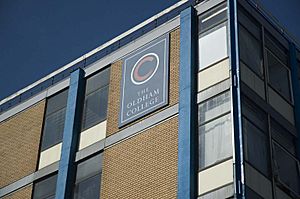
Oldham is linked to Hugh Oldham, who was appointed Bishop of Exeter in 1504. He later founded what is now Manchester Grammar School, which is considered a great gift to education.
University Campus Oldham is a center for higher education. It is a sister campus of the University of Huddersfield. It was opened in May 2005 by actor Patrick Stewart. The campus has given honorary doctorates to famous people from Oldham, like actress Shobna Gulati and artist Brian Clarke.
| School | Type/Status | OfSTED report |
|---|---|---|
| The Blue Coat School | Secondary school and Sixth form college | 137133 |
| Hulme Grammar School | Grammar school | N/A |
| New Bridge School | Secondary special school | 138697 |
| Oasis Academy Oldham | Secondary school | 136027 |
| Oldham Academy North | Secondary school | 136115 |
| Oldham College | Further education college | 130505 |
| Oldham Sixth Form College | Sixth form college | 145002 |
| The Hathershaw College | Secondary school | 137039 |
| Waterhead Academy | Secondary school | 144508 |
Public Services
Home Office policing in Oldham is handled by the Greater Manchester Police. Their headquarters for the Metropolitan Borough of Oldham are in central Oldham. Public transport is managed by Transport for Greater Manchester.
Emergency fire and rescue services are provided by the Greater Manchester Fire and Rescue Service. They have two stations in Oldham.
The Royal Oldham Hospital, located near Oldham's border with Royton, is a large NHS hospital. It opened in 1989.
Waste management is handled by the local authority through the Greater Manchester Waste Disposal Authority. Oldham's electricity is supplied by United Utilities. United Utilities also manages Oldham's drinking and waste water. Water comes from local reservoirs like Dove Stone. There is a water treatment plant at Waterhead.
Culture and Arts
Oldham is known for its theater history. In 1908, it had six "fine" theaters. Oldham is home to the Oldham Coliseum Theatre and the Oldham Theatre Workshop. These places helped start the careers of famous actors and writers like Eric Sykes and Bernard Cribbins. The Oldham Coliseum Theatre is one of Britain's last remaining repertory theatres. Famous performers like Charlie Chaplin and Stan Laurel appeared there in the early 1900s. More recently, actors like Ralph Fiennes have performed there.
In the 1800s, the circus was a popular form of entertainment in Oldham. Pablo Fanque's circus often visited, filling a 3,000-seat amphitheater.
The Lyceum is a Grade II listed building that opened in 1856. It cost £6,500 and was a center for "mutual improvement" for working men in Oldham. It offered a library, a newsroom, and lectures on various subjects. Music was also important, and a school of music opened there in 1892.
The Lyceum continued as an arts center throughout the 1900s. The Lyceum Players are an amateur theater company that performs there. In 1989, the Oldham Metropolitan Borough Music Centre moved into the Lyceum building. It is now the home of the Oldham Lyceum School of Music.
Oldham's museum and gallery service started in 1883. It has one of the largest and most varied collections in North West England. The collection includes over 12,000 items related to social and industrial history, over 2,000 artworks, and many other items.
Oldham now has a new, modern art gallery called Gallery Oldham. It opened in February 2002 as the first part of the Oldham Cultural Quarter. Later, an expanded Oldham Library and a lifelong learning center also opened. There are plans for a performing arts center too.
Oldham Carnival: A Community Celebration
The annual Oldham Carnival began around 1900, but the tradition of carnivals in the town goes back much further. Carnivals offered a "welcomed break from the boredom of everyday life." The main goal of the carnival parade was always to raise money for charities. It often featured local important people or popular entertainers. There were also brass bands, military bands, jazz bands, the Carnival Queen, people in fancy dress, dancers, and decorated floats from local churches and businesses.
The carnival parade used to start in the town center, go along King Street, and end with a party in Alexandra Park. The carnival became less popular in the late 1990s. However, community volunteers brought it back in 2006 and renamed it the Peoples' Carnival. In 2011, the parade moved into Alexandra Park. The event now has live stages and other activities along with a parade in the park.
International Connections
Twin Towns
Oldham is twinned with:
- Geesthacht, Schleswig-Holstein, Germany
- Kranj, Upper Carniola, Slovenia
Britain in Bloom Success
Oldham has been very successful in the "best city" category of the national Britain in Bloom competition. It won in 2012 and 2014, and in several years after that. It also received a gold award in 2019.
Oldham Council provides financial support for these awards. It is one of only five local authorities in the North West to do so.
Famous People from Oldham
Many notable people come from Oldham. These include TV game show host Tony Barber, radio announcer and singer Nick Grimshaw, actors Eric Sykes, Bernard Cribbins, Christopher Biggins, Ricky Whittle, Shobna Gulati, Dora Bryan, Anne Kirkbride, Olivia Cooke, Sarah Lancashire, and Cora Kirk. Also from Oldham are TV host Phillip Schofield, science educator Brian Cox, journalist John Stapleton, and comedy duo Cannon and Ball.
Famous musicians from Oldham include the bands Inspiral Carpets and N-Trance, as well as Mark Owen from the boyband Take That. The founding members of the rock band Barclay James Harvest are also from Oldham.
Akke Rahman, a charity mountaineer and the first British Muslim to climb Mount Everest, is from Oldham.
See also
 In Spanish: Oldham para niños
In Spanish: Oldham para niños


